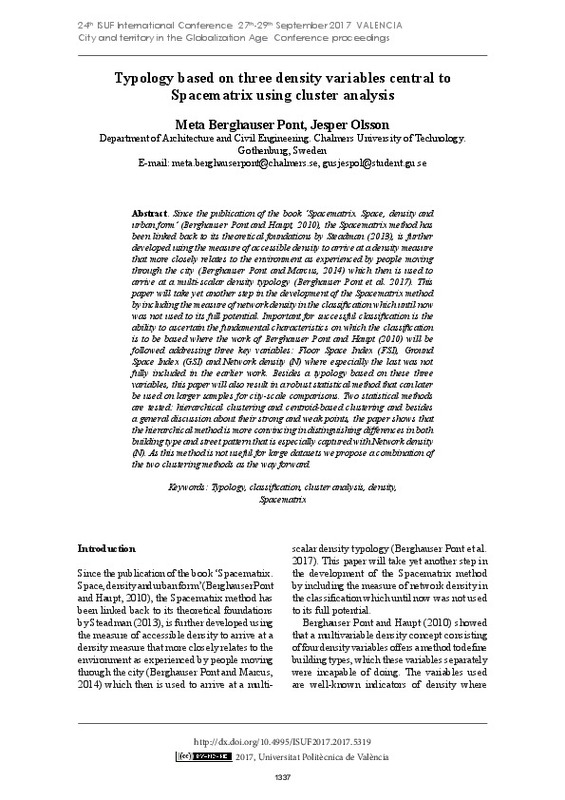JavaScript is disabled for your browser. Some features of this site may not work without it.
Buscar en RiuNet
Listar
Mi cuenta
Estadísticas
Ayuda RiuNet
Admin. UPV
Typology based on three density variables central to Spacematrix using cluster analysis
Mostrar el registro sencillo del ítem
Ficheros en el ítem
| dc.contributor.author | Berghauser Pont, Meta
|
es_ES |
| dc.contributor.author | Olsson, Jesper
|
es_ES |
| dc.date.accessioned | 2018-12-18T08:37:44Z | |
| dc.date.available | 2018-12-18T08:37:44Z | |
| dc.date.issued | 2018-04-20 | |
| dc.identifier.isbn | 9788490485743 | |
| dc.identifier.uri | http://hdl.handle.net/10251/114048 | |
| dc.description.abstract | [EN] Since the publication of the book ‘Spacematrix. Space, density and urban form’ (Berghauser Pont and Haupt, 2010), the Spacematrix method has been linked back to its theoretical foundations by Steadman (2013), is further developed using the measure of accessible density to arrive at a density measure that more closely relates to the environment as experienced by people moving through the city (Berghauser Pont and Marcus, 2014) which then is used to arrive at a multi-scalar density typology (Berghauser Pont et al. 2017). This paper will take yet another step in the development of the Spacematrix method by including the measure of network density in the classification which until now was not used to its full potential. Important for successful classification is the ability to ascertain the fundamental characteristics on which the classification is to be based where the work of Berghauser Pont and Haupt (2010) will be followed addressing three key variables: Floor Space Index (FSI), Ground Space Index (GSI) and Network density (N) where especially the last was not fully included in the earlier work. Besides a typology based on these three variables, this paper will also result in a robust statistical method that can later be used on larger samples for city-scale comparisons. Two statistical methods are tested: hierarchical clustering and centroid-based clustering and besides a general discussion about their strong and weak points, the paper shows that the hierarchical method is more convincing in distinguishing differences in both building type and street pattern that is especially captured with Network density (N). As this method is not useful for large datasets we propose a combination of the two clustering methods as the way forward. | es_ES |
| dc.format.extent | 12 | es_ES |
| dc.language | Inglés | es_ES |
| dc.publisher | Editorial Universitat Politècnica de València | es_ES |
| dc.relation.ispartof | 24th ISUF International Conference. Book of Papers | es_ES |
| dc.rights | Reconocimiento - No comercial - Sin obra derivada (by-nc-nd) | es_ES |
| dc.subject | Tipology | es_ES |
| dc.subject | Classification | es_ES |
| dc.subject | Cluster analysis | es_ES |
| dc.subject | Density | es_ES |
| dc.subject | Spacematrix | es_ES |
| dc.title | Typology based on three density variables central to Spacematrix using cluster analysis | es_ES |
| dc.type | Capítulo de libro | es_ES |
| dc.type | Comunicación en congreso | es_ES |
| dc.identifier.doi | 10.4995/ISUF2017.2017.5319 | |
| dc.rights.accessRights | Abierto | es_ES |
| dc.description.bibliographicCitation | Berghauser Pont, M.; Olsson, J. (2018). Typology based on three density variables central to Spacematrix using cluster analysis. En 24th ISUF International Conference. Book of Papers. Editorial Universitat Politècnica de València. 1337-1348. https://doi.org/10.4995/ISUF2017.2017.5319 | es_ES |
| dc.description.accrualMethod | OCS | es_ES |
| dc.relation.conferencename | 24th ISUF 2017 - City and Territory in the Globalization Age | es_ES |
| dc.relation.conferencedate | Septiembre 27-29,2017 | es_ES |
| dc.relation.conferenceplace | Valencia, Spain | es_ES |
| dc.relation.publisherversion | http://ocs.editorial.upv.es/index.php/ISUF/ISUF2017/paper/view/5319 | es_ES |
| dc.description.upvformatpinicio | 1337 | es_ES |
| dc.description.upvformatpfin | 1348 | es_ES |
| dc.type.version | info:eu-repo/semantics/publishedVersion | es_ES |
| dc.relation.pasarela | OCS\5319 | es_ES |








